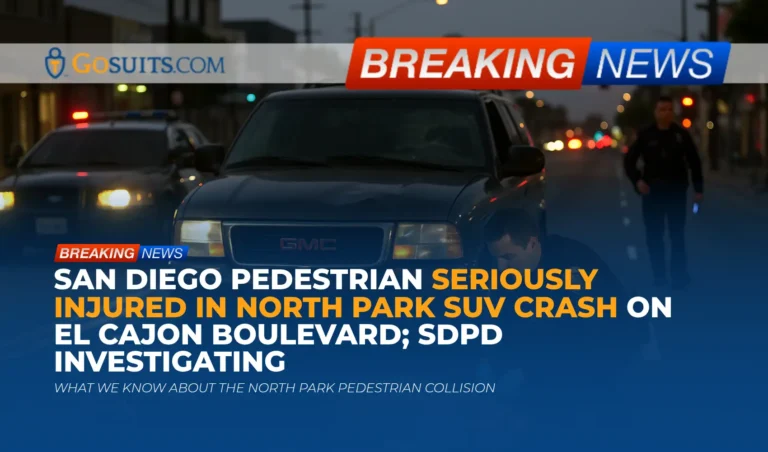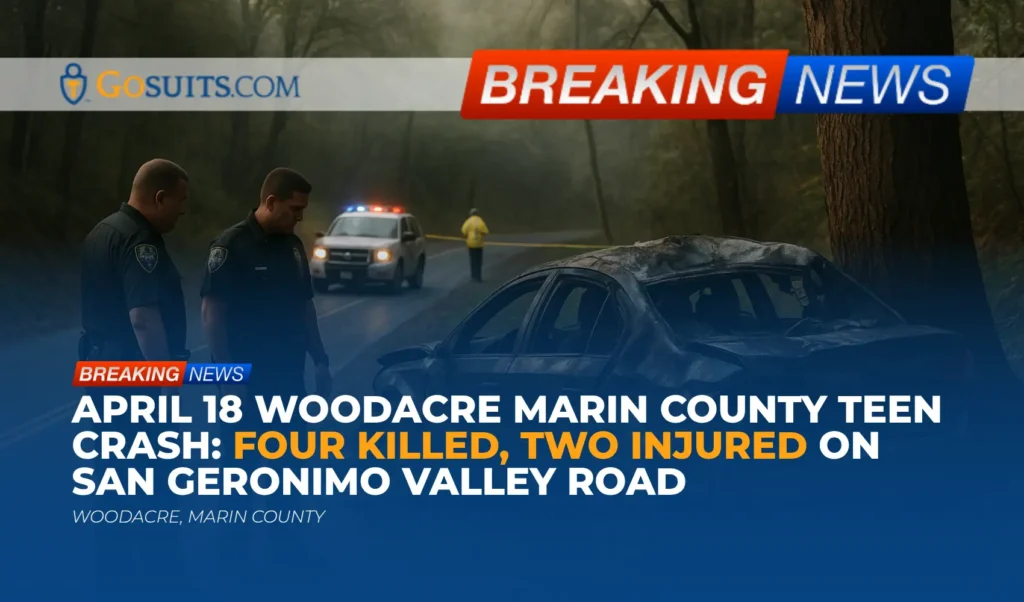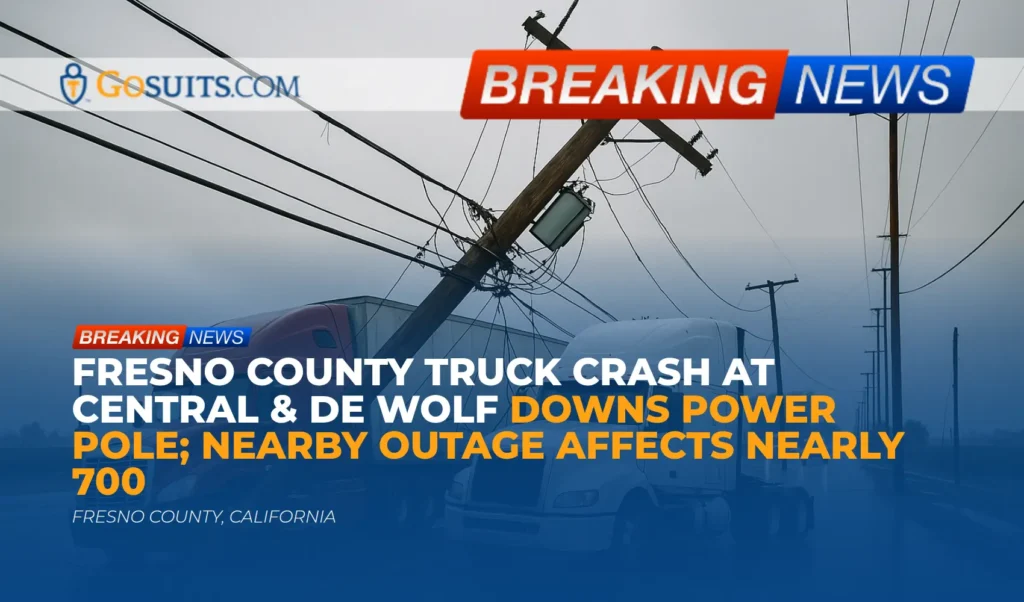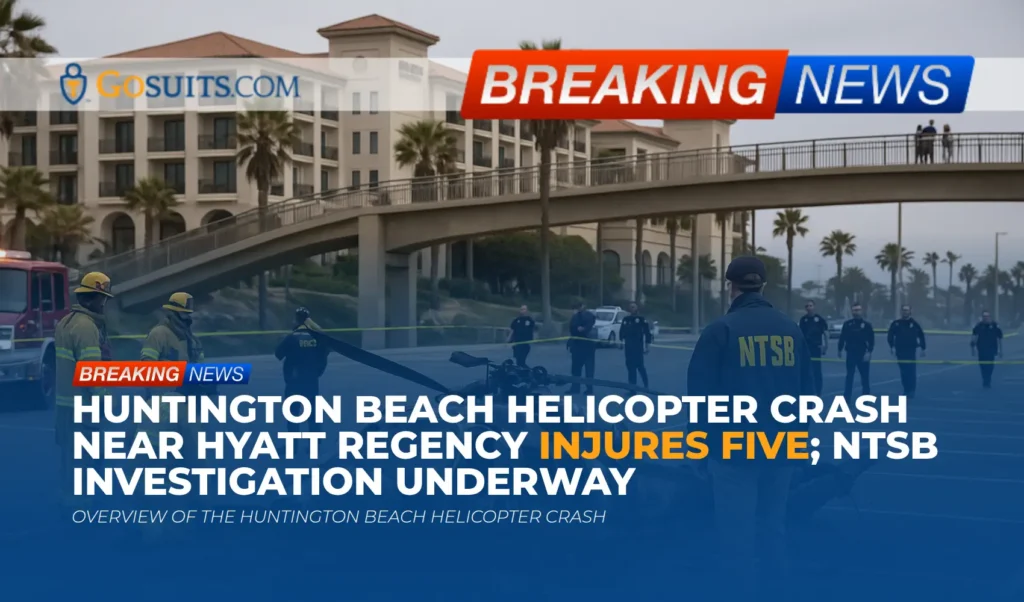- What we know about the North Park pedestrian collision
- Key questions people often have after a pedestrian crash
- Pedestrian and driver duties under California law
- How fault may be evaluated in a mid-block or median crossing
- Injuries and recovery after pedestrian impacts
- Insurance considerations in California pedestrian collisions
- Practical steps to preserve rights and evidence
- Where to obtain official records and information in San Diego
- Time limits and special claim rules in California
- Community safety context: North Park, El Cajon Boulevard, and vision zero
- Why timely action matters after a pedestrian collision
- Commentary from Gosuits San Diego, California Personal Injury Attorney
- Sources
What we know about the North Park pedestrian collision
Authorities reported that a pedestrian was seriously injured in North Park when he entered the path of an SUV on El Cajon Boulevard. According to San Diego Police Department, a 50-year-old man was running northbound across the highway divider in the 3100 block of El Cajon Boulevard when he moved into the path of a GMC Jimmy driven by a 70-year-old man. The crash occurred around 6:25 p.m. on Sunday. The pedestrian sustained a fractured pelvis and a facial laceration, and SDPD’s traffic unit is handling the investigation. Those are the details provided publicly at this time.
This section summarizes the initial report. Investigations by SDPD traffic officers typically include scene measurements, vehicle inspections, witness interviews, and review of nearby video. As more information becomes available, the understanding of contributing factors may evolve.
Key questions people often have after a pedestrian crash
When a serious pedestrian injury occurs, families and community members often ask practical questions. The points below are intended to provide clarity and direction in the immediate aftermath.
- What happened and who is investigating? SDPD’s traffic unit is leading the investigation. Their work usually covers vehicle speed estimates, sight lines, lighting, pedestrian movement and timing, and any roadway design issues.
- Who has the right of way? In California, the right of way depends on whether the person is in a marked crosswalk, an unmarked crosswalk at an intersection, or crossing mid-block. State law allocates duties to both drivers and pedestrians, which can share responsibility depending on the facts.
- Is crossing at a median or highway divider allowed? Crossing through a median mid-block implicates specific rules about crosswalks and mid-block crossings. Even where crossing outside a crosswalk, drivers must still use due care to avoid collisions, and pedestrians have a duty to yield to approaching vehicles.
- What injuries are common? Pelvic fractures and facial lacerations are consistent with pedestrian impacts and can require extensive treatment and rehabilitation.
- What insurance might apply? Potential sources include a driver’s liability coverage, the injured person’s medical coverage, and sometimes MedPay under an auto policy. California’s insurance framework is at-fault, and statements made to insurers can affect outcomes.
- What records should be collected? Police collision reports, 911 audio, traffic camera footage, and medical records are important. In fatal cases, the Medical Examiner’s records, including autopsy and toxicology, may be relevant to civil claims, though that is not the situation reported here.
- Are there deadlines? California law sets specific time limits to bring claims, with shorter timelines when public entities may be involved due to roadway conditions or signals.
Pedestrian and driver duties under California law
California law assigns responsibilities to both drivers and pedestrians. Even when one person has the technical right of way, both must act with care to prevent harm. The following state statutes provide important guidance.
- Crosswalks and yielding duties
- Drivers must yield the right of way to a pedestrian crossing the roadway within any marked crosswalk or unmarked crosswalk at an intersection. See Vehicle Code § 21950.
- Pedestrians must not suddenly leave a curb or other place of safety and walk or run into the path of a vehicle so close as to constitute an immediate hazard. See § 21950.
- Even when a pedestrian is crossing outside a crosswalk, drivers must exercise due care to avoid colliding with any pedestrian. See Vehicle Code § 21954.
- Crossing outside a crosswalk
- Pedestrians crossing outside a crosswalk must yield the right of way to vehicles so near as to constitute an immediate hazard. See § 21954.
- Between adjacent intersections controlled by traffic signals, pedestrians are to cross only in crosswalks. See Vehicle Code § 21955.
- What is a crosswalk?
- California defines crosswalks to include marked crosswalks and unmarked crosswalks at intersections. See Vehicle Code § 275.
- Driver speed and due care
- Drivers must never drive at a speed greater than is reasonable or prudent given traffic, visibility, and roadway conditions. See the basic speed law, Vehicle Code § 22350.
- Recent change: “Freedom to Walk” Act
- Effective 2023, California limited enforcement of “jaywalking” to situations where a reasonably careful person would realize there is an immediate danger of a collision. While this may affect citations, it does not eliminate pedestrian duties or civil fault analysis. See AB 2147 (2022).
These laws work together. In plain terms, pedestrians must not step or run into moving traffic so close that a driver cannot reasonably avoid a collision, and drivers must anticipate and avoid people in the roadway when they can do so safely. Civil cases may assess how both sets of duties were met under the particular conditions present at the time.
How fault may be evaluated in a mid-block or median crossing
The report notes that the pedestrian was running north across the highway divider on El Cajon Boulevard and entered the path of an SUV. In California, fault is not necessarily all-or-nothing. Responsibility can be shared if evidence shows that both a pedestrian and a driver contributed to the collision. California uses a comparative fault system in civil cases, which allows fact finders to allocate percentages of responsibility to each party based on the evidence. The Judicial Council’s civil jury instructions discuss this concept. See Judicial Council of California Civil Jury Instructions (CACI), Comparative Fault.
Key factors investigators and insurers often analyze include:
- Location of crossing Mid-block crossings through a median are common along wide boulevards. If the pedestrian was not within a marked or unmarked crosswalk, § 21954 places a duty on the pedestrian to yield to vehicles that constitute an immediate hazard.
- Driver awareness and speed Under the basic speed law, drivers must operate at a speed that is reasonable given visibility, lighting, traffic, and potential for pedestrians. The question is often whether a reasonable driver could have seen the person in time and braked or avoided them, see § 22350.
- Lighting and sight lines The crash time was around 6:25 p.m. Whether it was daylight or dusk can influence visibility. Street lighting, headlight use, and any visual obstructions near the median are relevant.
- Pedestrian movement Running across travel lanes changes timing calculations for closing speed. Investigators consider whether the movement created an immediate hazard under § 21950.
- Vehicle condition and evasive action Skid marks, anti-lock brake activation, and vehicle damage patterns can indicate speed and driver reaction. Event data recorders in some vehicles may store pre-impact speed and braking information.
- Roadway design and traffic control Median design, crosswalk locations, signal timing, and safe crossing opportunities matter. Where infrastructure leaves long distances between safe crossing points, risk can increase, and time-distance analysis may be important.
Because responsibility can be divided, it is essential to understand that even if a pedestrian is found to have contributed to the collision, there may still be a path to recovery for harms caused by the other party’s negligence under comparative fault principles. Each case turns on its specific evidence.
Injuries and recovery after pedestrian impacts
A fractured pelvis and facial laceration can be life-changing. Pelvic fractures may involve the ring of bones connecting the spine to the legs and can range from stable injuries to complex fractures involving multiple breaks and internal bleeding. Treatment may include surgery, external fixation, transfusions, and careful rehabilitation. Facial lacerations can require suturing, plastics consultation, and follow-up care to minimize scarring and manage infection risk.
Pedestrians are vulnerable because they lack the protective structure of a vehicle. Nationally, pedestrian fatalities reached high levels in recent years, underscoring the severity of these incidents. The National Highway Traffic Safety Administration reports thousands of pedestrian deaths annually, with many more injuries requiring hospitalization. See NHTSA: Pedestrian Safety and the federal data summary in Traffic Safety Facts: Pedestrians. The Centers for Disease Control and Prevention further highlights that pedestrians are at higher risk for severe injuries because speed and vehicle mass transfer directly to the body at impact. See CDC: Pedestrian Safety.
Beyond the physical, people may experience emotional trauma, anxiety, and stress following a sudden crash. Rehabilitation often involves coordinated care among trauma surgeons, physical therapists, and counselors, and attention to transportation and work accommodations during recovery.
Insurance considerations in California pedestrian collisions
California follows an at-fault insurance system. If a driver is found to have been negligent and that negligence caused harm, that driver’s liability insurance may be responsible for compensable losses. The pedestrian’s own auto policy may include Medical Payments (MedPay) coverage, and health insurance can address medical bills subject to policy terms and potential reimbursement rules. The California Department of Insurance provides consumer guidance on steps to take after an auto collision and working with insurers; see California Department of Insurance: After an Accident.
A few core points to keep in mind:
- Comparative fault affects claims If both parties share responsibility, an insurer may reduce payment by the percentage of fault assigned to the claimant, consistent with California’s comparative fault principles.
- Recorded statements Insurers often request recorded statements quickly. It is prudent to consult an attorney first; statements given early can be used to limit or deny a claim later if phrased in a way that creates ambiguity.
- Medical billing and liens Health insurers and some medical providers may assert reimbursement rights from any settlement. Coordinating benefits and understanding lien resolution is an important part of the process.
- Uninsured and underinsured motorist coverage If the driver lacks adequate insurance, a pedestrian’s own auto policy may provide coverage through UM/UIM, where purchased.
If roadway conditions, signage, or signals contributed to the crash, claims may involve public entities. Those claims have special notice requirements and shorter deadlines, discussed below.

Practical steps to preserve rights and evidence
Evidence can disappear quickly in traffic cases. Steps taken in the first days and weeks can make a real difference. The following is general guidance.
- Request the police collision report The SDPD collision report will include diagrams, statements, and officer observations. Confirm the report number if possible, and request it as soon as it becomes available.
- Identify and contact witnesses Independent witnesses can clarify timing and movement across lanes, lighting, and evasive actions. Obtain names and contact details.
- Secure video Nearby businesses and transit vehicles may have footage. Ask promptly, as many systems overwrite within days. Intersection cameras and city-owned devices may be accessible through public records processes.
- Document the scene Photographs of the median, lane markings, lighting, nearby crosswalks, and any debris or scuff marks help reconstruct events.
- Preserve physical items Keep footwear and clothing. They can show impact points and traction conditions.
- Track medical care and symptoms Maintain copies of imaging, discharge summaries, and follow-up plans. Note pain levels, mobility limits, and how injuries affect daily activities and work.
- Avoid social media commentary Public posts can be misinterpreted and used to challenge injury severity or fault.
- Speak with a qualified attorney before insurers Before giving statements or signing authorizations, consider a free consultation to understand rights and how comparative fault might be applied. What is said to insurance companies can be used against a claimant later.
Where to obtain official records and information in San Diego
Families and community members often need official records to understand what happened and to navigate insurance. Below are direct, public resources.
- San Diego Police Department collision reports
- SDPD provides information on requesting traffic collision reports through its Records service. See San Diego Police Department Records.
- 911 audio and public records
- Some records may be available via the City’s public records process. The City’s portal explains how to submit requests. See City of San Diego Public Records.
- Medical Examiner (for fatalities)
- In fatal cases, the San Diego County Medical Examiner provides information on reports, identification, and next-of-kin support. See San Diego County Medical Examiner. Note: the North Park crash described here was reported as non-fatal.
- Roadway hazards and infrastructure
- To report lighting, signal, or roadway issues within the City, use the City’s service portal. See City of San Diego: Get It Done.
- For state highway issues, Caltrans provides a customer service request system. See Caltrans Customer Service Request.
- Traffic safety facts for context
- The California Office of Traffic Safety provides statewide facts and local rankings that can help frame risk on urban corridors. See California OTS: Traffic Safety Facts.
Time limits and special claim rules in California
Legal deadlines in California are strict. Missing them can forfeit the right to bring a claim. While the exact application depends on the facts, the following statutes provide general timelines.
- General personal injury timeline
- Most personal injury claims must be filed within two years of the injury. See Code of Civil Procedure § 335.1.
- Claims involving public entities
- If a roadway condition, signal timing, or other government-related factor is alleged to have contributed, a government claim usually must be presented within six months of the incident before a lawsuit can be filed. See Government Code § 911.2.
Because exceptions and tolling rules can apply in limited circumstances, it is prudent to review deadlines early. Doing so helps ensure that evidence gathering, medical documentation, and expert analysis have enough time to develop before a filing window closes.
Community safety context: North Park, El Cajon Boulevard, and vision zero
El Cajon Boulevard is a wide urban corridor with multiple lanes and medians that draw significant vehicle and pedestrian activity. Corridors like this often feature longer distances between crosswalks and complex lighting, which can affect where and how people cross, especially around evening hours.
California and the City of San Diego have adopted Vision Zero goals to reduce severe traffic injuries and fatalities. The City’s program outlines engineering, enforcement, and education strategies prioritized on high-injury networks where a disproportionate share of severe crashes occur. See City of San Diego: Vision Zero. Statewide, the Office of Traffic Safety tracks progress and trends. See California OTS traffic safety facts.
For community members, awareness of safer crossing options, nighttime visibility, and vehicle speed management remain central to harm reduction. For public agencies, lighting improvements, crosswalk frequency, and median refuge design can help reduce risk where people must cross multi-lane roadways.
Why timely action matters after a pedestrian collision
This section is intended to help readers understand why swift, thoughtful steps are important after a serious crash. It does not direct anyone to contact a particular firm.
- Confirm and document the incident Obtain the police report number, request the collision report when available, and write down what happened while details are fresh. Waiting risks memory fade and the loss of essential context.
- Collect and preserve evidence Ask nearby businesses for video promptly because many systems automatically overwrite footage within days. Photograph the scene, the median, lane markings, lighting, and any visible injuries. This creates a clear record for later evaluation.
- Coordinate medical care Follow treatment plans and keep copies of imaging and discharge summaries. Consistent care both supports recovery and provides objective documentation of the injury course.
- Be cautious with insurance communications Before giving recorded statements or signing medical releases, consult an attorney. Early statements can shape how liability is viewed and may affect available compensation.
- Calendar deadlines Note the two-year personal injury filing timeline and the six-month government claim requirement if public infrastructure may be involved. Early attention prevents last-minute surprises.
- Consider professional guidance A free consultation can clarify rights, responsibilities, and strategy under California’s comparative fault system. Understanding options early can reduce stress and help avoid missteps.
Acting promptly helps ensure that critical information is not lost and that the path forward is based on a complete, accurate picture of what happened.

Commentary from Gosuits San Diego, California Personal Injury Attorney
Our thoughts are with the injured man and his loved ones after this serious collision on El Cajon Boulevard. A fractured pelvis and facial injuries are painful and disruptive, and we extend sincere concern for his recovery. The information provided here is for general educational purposes to help the community understand common legal and safety issues that arise after pedestrian crashes.
Based on the report, investigators will be examining how and where the crossing occurred, what the driver could reasonably perceive at that time and distance, and whether speed, lighting, or roadway design played a role. California law requires care from everyone using the road. Pedestrians may not suddenly enter the path of vehicles that are so close as to be an immediate hazard, and drivers must operate at a safe speed and use due care to avoid people in the roadway. The outcome often turns on careful, fact-specific analysis: sight lines, vehicle speed, lane positions, and available safe crossing options near the median.
In our experience, insurance companies and large entities move quickly after a crash to shape the narrative. They may ask for recorded statements, request broad medical authorizations, or rely on incomplete snippets of evidence to assign blame. People unfamiliar with the process can feel pressured to speak before they have a full understanding of the facts, and those early statements can be used later to dispute liability or minimize injuries. A brief, no-cost consultation can help individuals understand rights, comparative fault, and how to avoid common pitfalls before engaging with insurers.
Taking time to review the police report, gather video, and coordinate medical documentation makes a substantial difference. Understanding California’s timelines and special rules for claims involving public infrastructure is equally important. Knowledge is a practical safeguard that helps ensure any later negotiations are grounded in the complete evidence, not assumptions.
Sources
- California Vehicle Code § 21950 (Driver duties to yield; pedestrian duties not to enter immediate hazard; due care by drivers).
- California Vehicle Code § 21954 (Pedestrians crossing at places other than crosswalks).
- California Vehicle Code § 21955 (Between signalized intersections, cross only in crosswalks).
- California Vehicle Code § 275 (Definition of crosswalk).
- California Vehicle Code § 22350 (Basic speed law).
- AB 2147 (2022) (Freedom to Walk Act; limits jaywalking enforcement to immediate hazard situations).
- Judicial Council of California, CACI (Comparative fault framework used in civil cases).
- Code of Civil Procedure § 335.1 (Two-year statute of limitations for personal injury).
- Government Code § 911.2 (Six-month claim presentation requirement to public entities).
- California Department of Insurance (Consumer guidance after auto accidents).
- NHTSA: Pedestrian Safety and Traffic Safety Facts: Pedestrians (National data and safety strategies).
- CDC: Pedestrian Safety (Injury mechanisms and prevention).
- San Diego Police Department Records (How to request traffic collision reports).
- City of San Diego Public Records (Public records requests, including certain audio and video).
- San Diego County Medical Examiner (For fatal cases: reports and guidance for next-of-kin).
- City of San Diego: Get It Done (Report local infrastructure issues like lighting and signals).
- Caltrans Customer Service Request (Report state roadway issues).
- California Office of Traffic Safety (Statewide traffic safety facts and trends).
- City of San Diego: Vision Zero (Local strategy to reduce serious traffic injuries and fatalities).






